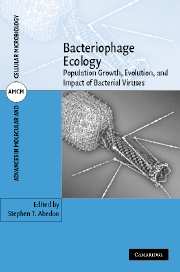Book contents
- Frontmatter
- Contents
- About the cover
- List of contributors
- Foreword by Bruce R. Levin
- Preface
- 1 Phages, ecology, evolution
- Part I Phage ecology
- Part II Phage evolutionary biology
- 6 Phage evolutionary biology
- 7 Phage evolution
- 8 Evolutionary ecology of multiple phage adsorption and infection
- 9 Patterns in phage experimental adaptation
- Part III Phage ecology in environments
- Part IV Modeling phage ecology
- Index
- Plate section
6 - Phage evolutionary biology
from Part II - Phage evolutionary biology
Published online by Cambridge University Press: 29 September 2009
- Frontmatter
- Contents
- About the cover
- List of contributors
- Foreword by Bruce R. Levin
- Preface
- 1 Phages, ecology, evolution
- Part I Phage ecology
- Part II Phage evolutionary biology
- 6 Phage evolutionary biology
- 7 Phage evolution
- 8 Evolutionary ecology of multiple phage adsorption and infection
- 9 Patterns in phage experimental adaptation
- Part III Phage ecology in environments
- Part IV Modeling phage ecology
- Index
- Plate section
Summary
INTRODUCTION
Evolutionary biology and microbiology, with the ushering in of the molecular revolution, developed a tenuous relationship (Woese, 1994). Further isolating these disciplines, once unified university biology departments split in two, with organismal versus molecular emphases. Because phage biologists were pioneers in molecular biology, they were placed on the molecular side of the divide along with the rest of microbiology, whereas evolutionary biologists, with their less reductionist approaches to biology, were grouped with researchers in zoology, botany, paleontology, and ecology (Rouch, 1997). Consequently, microbiologists were physically isolated from model organism researchers such as Drosophila evolutionary geneticists, and intellectually removed from discoveries such as rapid ecological radiations of wild populations and theories explaining biodiversity and speciation. Evolutionary biologists, in turn, were isolated from microbial experiments that bore on evolution, even though some historically significant discoveries in evolutionary biology used microbes, especially bacteriophages. Despite these past rifts, there exists a newfound appreciation for the power of using microbes to explore evolution and ecology: as molecular researchers had long realized, there are profound advantages to employing small, relatively simple, and rapidly replicating organisms as models for deciphering universal biological truths. Microbiologists, too, in this age of genomics, are increasingly aware of the crucial importance of ecology and evolution in their research.
- Type
- Chapter
- Information
- Bacteriophage EcologyPopulation Growth, Evolution, and Impact of Bacterial Viruses, pp. 147 - 176Publisher: Cambridge University PressPrint publication year: 2008
- 3
- Cited by



